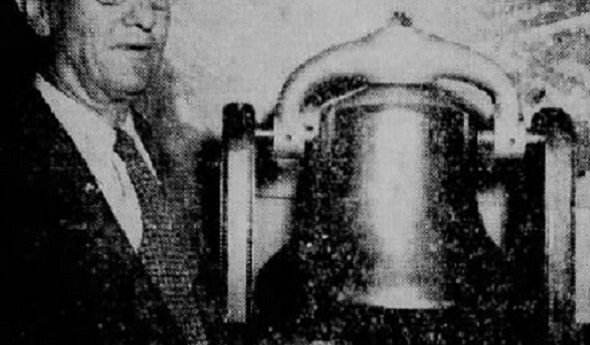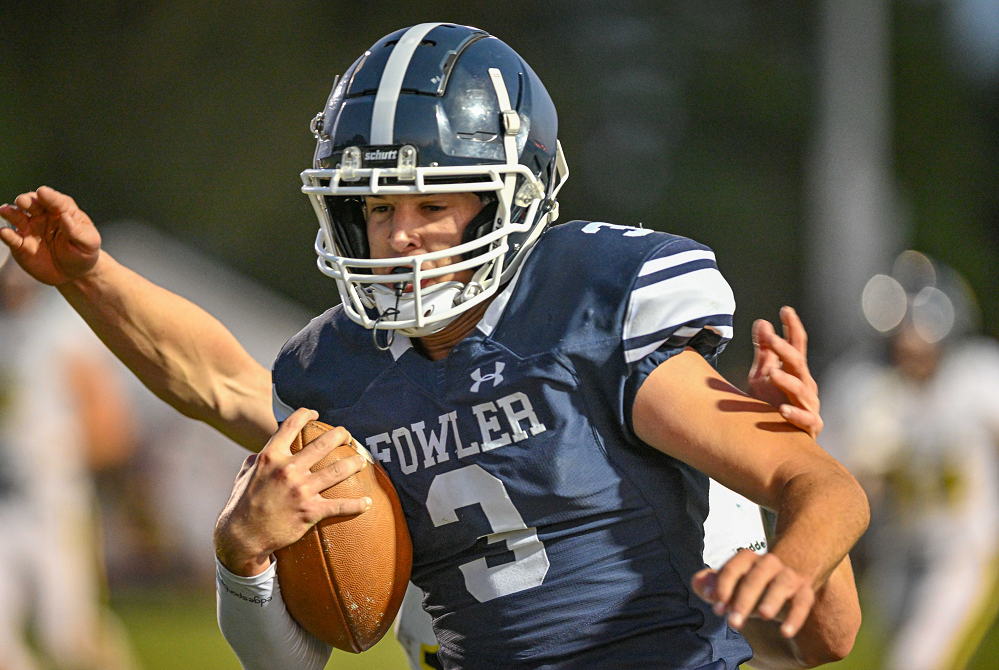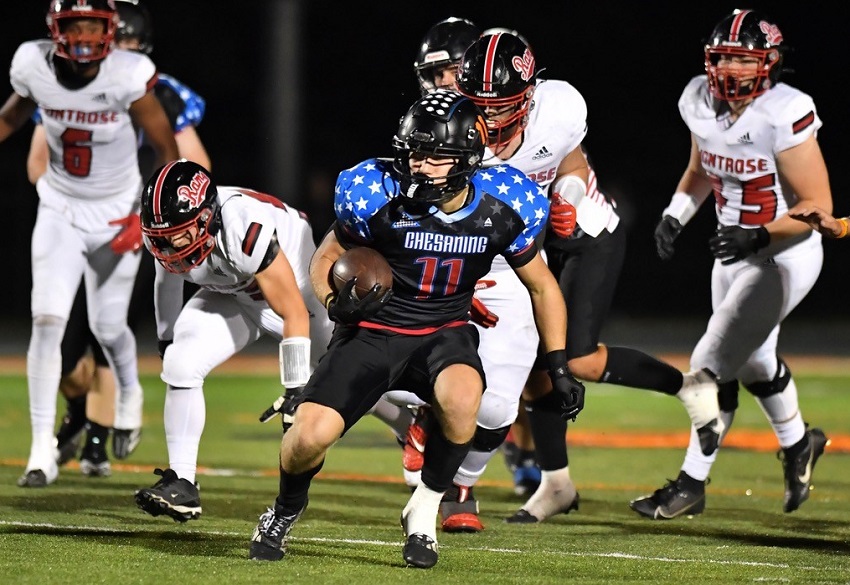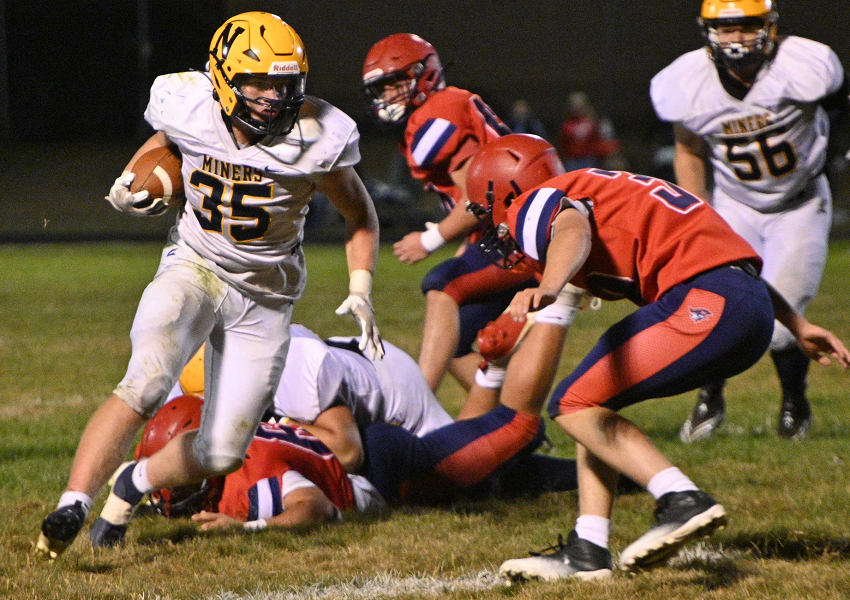
#TBT: Searching for The Hinker Bell
September 28, 2017
By Geoff Kimmerly
Second Half editor
Menominee will host Escanaba on Friday in the 121st meeting between two of the Upper Peninsula’s largest high schools and proudest football programs – but with the trophy celebrating the game still missing after it first disappeared more than half a century ago.
The two teams from 1948-1962 played for the The Hinker Bell, a locomotive bell that hasn’t been seen since 1963.
A decade ago, Escanaba Daily Press sports editor (and now Second Half correspondent) Denny Grall wrote about a newfound search for The Hinker Bell. But the mystery continues, and Grall’s story below tells of many of the twists and turns that to that point that had come in trying to locate it.
ESCANABA — Another search is underway to find the Hinker Bell.
The former locomotive bell went to the winner of the Escanaba-Menominee football game for about 15 years but has been missing for more than 40 years. It came from a locomotive owned by the Bay de Noquet Company and used on the LS&I Railroad that operated in Delta and Menominee counties.
The locomotive was built in 1906 by Baldwin Locomotive Works in Philadelphia and the bell was believed to have been cast in the railroad foundry, according to a 1953 newspaper clipping.
In 1948, one of the locomotive owners presented the bell to his friend, John Hinker of Menominee, an ardent sports fan who donated materials for the press box at Menominee’s Walton Blesch Field.
 Hinker gave the bell to then Menominee coach Mickey McCormick and indicated proper use for the bell would be as an award for the gridiron rivalry.
Hinker gave the bell to then Menominee coach Mickey McCormick and indicated proper use for the bell would be as an award for the gridiron rivalry.
Now Hinker’s great great nephew is trying to find the bell, which has not been seen since Escanaba’s current high school opened in 1963.
Tim Waters of Land O’ Lakes, Wis., who has launched the search, became interested by researching his family tree. “It is a big trophy (between 80 and 150 pounds by various estimates) and it is odd that it is missing,” Waters said in a recent telephone chat.
“One theory is that it is in somebody’s hunting camp or a home and they are using it as their own trophy,” said Waters.
“We have a pretty good investigation going on and all help is appreciated. If somebody does have it, we’re not looking to prosecute them. We’re just looking to get the darn thing back. Nobody will be in trouble.”
Waters refuted the old idea the bell was melted down. He has contacted numerous bell collectors, and they said a junk yard would have known it was worth a lot more than melted metal.
“The bell was not destroyed. We’ve come to that conclusion,” he said. “It was not put in a scrap yard.”
Waters contacted Coplan Iron and Metal of Escanaba and learned that bells were not melted or crushed and said the firm never accepted a bell with engravings matching the Hinker Bell.
Waters learned those businesses would sell them for the weight value to people who wanted them for yard ornaments/dinner bells, or to collectors.
“It is a treasure and it needs to be found,” said Waters.
Waters said the last known photo of the bell was with then EHS football coach Al Sigman and Esky players John Fisher and Phil Davidson in 1960. Escanaba beat Menominee from 1959-63 but could not find the bell in 1964 when the Maroons won. No one he has talked to remembers seeing the bell present at the first three games during the tenure of coach Jerry Cvengros.
The current Escanaba High School opened in 1963 and Bay de Noc Community College then occupied the old facility, which has since been demolished.
“Records indicate there was no report (of a missing bell) filed by Escanaba school district to the police department,” Waters said.
“The Hinker Bell is part of U.P. Michigan’s history, as is football and the railroads,” Waters said. “The people of Escanaba and Menominee deserve to have this trophy returned to their high schools.”
Waters, who has never seen an Escanaba or Menominee football game but is planning to rectify that omission this season, is hoping students at the two schools will join in the treasure hunt and talk about it with their parents and grandparents.
He has already contacted EHS athletic director Rob Ryan, who plans to thoroughly search the school basement.
He would like to find a photo of the bell to help collectors in their search. “Each bell was for a special locomotive,” said Waters.
“If they have a good picture we can pass it around and say we are looking for this bell. If they can pinpoint what this bell was on, they can help get the word out.”
He has also extended the search to the website at upfootball.com, which has generated interest but no bell. “If the bell is in the area still today, I don’t think it will take long to surface,” he said.
“If we don’t find this bell, we are going to try to make up a replacement as close as possible if the two schools are interested in that,” he said.
Waters is hoping that real estate agents, postal workers, delivery personnel, construction workers, etc., may have seen the bell during their travels and can help retrieve it.

1st & Goal: 2024 Week 6 Review
By
Geoff Kimmerly
MHSAA.com senior editor
October 7, 2024
We don’t track margin of victory week to week during the Michigan high school football season. So only anecdotally we will say that Week 6 felt like it was filled with several more close games than usual across the state.
 Total, 57 games were decided by eight points or fewer – in essence, a touchdown and 2-point conversion, or less – and those 57 games including 113 Michigan teams (with River Rouge playing an Ohio opponent).
Total, 57 games were decided by eight points or fewer – in essence, a touchdown and 2-point conversion, or less – and those 57 games including 113 Michigan teams (with River Rouge playing an Ohio opponent).
In other words, 19 percent of our varsity teams were part of games decided by such a slim margin – including many of the results of intriguing matchups we highlight below.
Bay & Thumb
HEADLINER Almont 29, Armada 28 Almont’s last-minute go-ahead score may end up deciding the Blue Water Area Conference championship as the Raiders (6-0) held on to win this matchup of undefeated teams. They can clinch a share of the title this week against Richmond, while Armada (5-1) fell into a second-place tie with North Branch – but with some hope as North Branch plays Almont in Week 8. Click for more from the Port Huron Times Herald.
Watch list Marysville 39, Marine City 20 Marysville (5-1) rebounded from a 35-0 opening-night loss to Almont to win five straight and clinch a share of the Macomb Area Conference Silver title – with an opportunity to win it outright this week against second-place St. Clair.
On the move Davison 35, East Lansing 10 Davison (5-1) built a strong nonleague schedule again for this season, and this final nonconference win bumped the Cardinals up to No. 9 in Division 1 playoff-point average while keeping East Lansing (3-3) still firmly in the Division 2 mix. Grand Blanc 35, Lapeer 21 The undefeated atop the Saginaw Valley League Red standings are down to Grand Blanc (5-1) and Davison, with Lapeer (4-2) holding on to a sliver of title share hope after taking its second league loss. Fenton 24, Linden 21 Fenton (6-0) took a field goal lead during the first quarter and continued to maintain that advantage to the end to clinch a share of the Flint Metro League Stripes title and send Linden to 3-3 – but with some title share hope as Fenton faces the other second-place team, Flushing, this week.
Greater Detroit
HEADLINER Trenton 28, Gibraltar Carlson 14 Trenton (4-2) has strung together a nice comeback over the last month, with this win the necessary first step toward a possible – and what not long ago probably seemed improbable – opportunity to claim a share of the Downriver League title. The Trojans started this fall 0-2 with both losses in the league, but handed Carlson (5-1) its first. This week Trenton faces Downriver leader Allen Park – and with Allen Park and Carlson still to play as well. Click for more from the Southgate News-Herald.
Check out the highlights of Trenton's 28-14 win over Gibraltar Carlson from October 4th, 2024. Delivered by @hungryhowies. After starting the season 0-2, Trenton has won 4 straight games.@OnwardTrenton | @AshtonRooney_1 pic.twitter.com/z5Owy7l54x
— STATE CHAMPS! Michigan (@statechampsmich) October 5, 2024
Watch list Clawson 27, Clinton Township Clintondale 14 Reigning MAC Bronze champion Clawson (4-2) broke this season’s league standings open again, denying Clintondale (4-2) the opportunity to clinch a share of the title and setting up the possibility of three winners this season with Hazel Park also tied for first, one league game left for all three, and none of those three playing each other.
On the move Detroit Lincoln-King 50, Mount Clemens 0 Lincoln-King (6-0) posted its third straight shutout on the field (with a forfeit win during that run as well) and can clinch the Charter School Conference Silver title this week after sending Mount Clemens (4-2) into a tie for third place. Clinton Township Chippewa Valley 34, Utica Eisenhower 31 (2 OT) All of a sudden the Big Reds (2-4) are only five spots out of making the Division 1 playoff field after stunning Eisenhower (5-1), which can still claim a share of the MAC Red title by defeating first-place Macomb Dakota this week. Oxford 18, Rochester Adams 17 After opening Oakland Activities Association Red play with an eight-point loss to Clarkston, Oxford has pushed back into a tie for first with a chance to clinch a share of the title this week against West Bloomfield. Oddly enough, Adams – with two league losses by a combined four points – could be part of a five-team title share if all five in the division finish 2-2 in league play.
Mid-Michigan
HEADLINER Fowler 14, Pewamo-Westphalia 11 Fowler (6-0) pulled into first place in the Central Michigan Athletic Conference and nearly pulled even with P-W (5-1) in their longstanding series. This was the Eagles’ second win in their last 10 meetings with the Pirates, but pulled Fowler to within one of tying P-W for wins in the 59-year rivalry. Click for more from the Lansing State Journal.
Watch list Leslie 36, Napoleon 28 With this win over reigning Cascades Conference East champion Napoleon (3-3), Leslie pulled within one more of clinching a share of this year’s title and with winless East Jackson up next. The Blackhawks (6-0) also have their most victories in a season since 2012, the last time they finished with a winning record.
On the move Ionia 21, Lansing Sexton 20 After this second-straight one-point win, Ionia (4-2) has avenged three of its losses from a year ago and needs two more victories to guarantee its best finish since 2013. Lansing Everett 35, Grand Ledge 12 Everett (5-1) bounced back from its loss to Grand Blanc with its first win over Grand Ledge (4-2) since 2019 – and with one more victory, would have its best finish since 2014. Mason 40, St. Johns 10 Mason (5-1) clinched a share of a sixth-straight Capital Area Activities Conference Red title by winning this matchup of league leaders, and also delivered St. Johns (5-1) its lone loss during what has been the Redwings’ best season since 2019.

Northern Lower Peninsula
HEADLINER Petoskey 42, Cadillac 18 The Northmen played themselves into a championship matchup in the Big North Conference this week, as they’ll face co-leader Marquette with two leagues games remaining for both. Petoskey also is 6-0 for the first time since 2011, tied last season’s win total with this one, and remains seventh in Division 3 playoff-point average while Cadillac (3-3) fell only one spot to No. 29. Click for more from the Petoskey News-Review.
Watch list Boyne City 21, Grayling 18 Boyne City (4-2) kept its destiny in its own hands, and it will face first-place Traverse City St. Francis in Week 9 with a chance to earn a share of the Northern Michigan Football League Legends championship.
On the move East Jordan 43, Mancelona 28 The Red Devils (4-2) bounced back from two-straight one-score losses to solidly reassert themselves in the middle of the potential Division 8 playoff field, with Mancelona (3-3) remaining in that mix as well. Traverse City St. Francis 55, Cheboygan 6 The Gladiators (5-1) won their third straight to clinch a share of the NMFL Legends title and send Cheboygan to 3-3. Charlevoix 28, Elk Rapids 0 The Rayders (4-2) are league champions as well with this clinching a share in the NMFL Leaders.
Southeast & Border
HEADLINER Monroe St. Mary Catholic Central 34, Riverview 15 Two straight power-packed weeks in the Huron League have left Monroe St. Mary Catholic Central in first place and Riverview and Flat Rock both a game back, with SMCC facing Flat Rock this week with at least a share of the league title on the line. This was billed as Riverview’s powerful offense against the Falcons’ unyielding defense, and the latter won out to give SMCC its first victory over the Pirates since 2019. Click for more from the Monroe News.
Watch list Dexter 42, Ann Arbor Pioneer 6 Dexter (6-0) clinched the Southeastern Conference Red championship, in part by sending Pioneer (4-2) into a tie for second place. The Dreadnaughts can claim the title outright this week at Monroe.
On the move Jackson Lumen Christi 63, Toledo St. Francis de Sales 35 In a winner-take-all for the Catholic High School League AA championship, Lumen Christi (5-1) clinched it and has won all six of its CHSL games since entering the league last fall. Ottawa Lake Whiteford 65, Erie Mason 8 Petersburg Summerfield clinched a share of the Tri-County Conference title by way of this Whiteford win, but the Bobcats (5-1) no doubt will be cheering for Mason next week to defeat Summerfield, which would create a shared title among all three. Chelsea 38, Tecumseh 14 Chelsea has strung together five straight wins after losing its season opener, and this one, combined with Adrian’s 17-14 victory over Jackson, gave the Bulldogs (5-1) the outright SEC White title.
Southwest Corridor
HEADLINER Kalamazoo United 33, Constantine 21 United’s first win over Constantine since 2018 ended the Falcons’ 23-game winning streak in the Southwestern Athletic Conference Lakeshore and put the Titans (5-1) in position to clinch a share of the league title this week if Constantine (5-1) defeats co-leader Parchment. United faces Parchment in Week 8. Click for more from the Kalamazoo Gazette.
Kalamazoo United wins big against Constantine. Final score 33-21! @kalamazoounited https://t.co/VNAbf9bl9Y pic.twitter.com/smtlnCVFBQ
— FOX 17 Blitz (@FOX17Blitz) October 5, 2024
Watch list Schoolcraft 17, Lawton 3 Schoolcraft (5-1) will face Saugatuck this week for a share of the SAC Valley title after sending Lawton (4-2) into third place by ending a five-game losing streak against the Blue Devils. Lawton had defeated the Eagles in both the regular season and playoffs the last two years.
On the move Battle Creek Harper Creek 32, Parma Western 13 Harper Creek (5-1) has played itself into a similar spot as last season – set to face Hastings with major Interstate 8 Athletic Conference implications. But this time, the Beavers have a win over Parma Western out of the way as they avenged last year’s loss to the third-place Panthers. Paw Paw 21, Edwardsburg 7 The Wolverine Conference race is likely to go to the end of the regular season, but this was a major obstacle to overcome as Paw Paw (6-0) moved closer to a Week 9 matchup with current co-leader and reigning champion Niles – which faces Edwardsburg (4-2) this week. Berrien Springs 31, Buchanan 6 Berrien Springs (3-3) won its second straight over the Bucks (3-3) and will face Dowagiac this week for a share of the Lakeland Conference championship.

Upper Peninsula
HEADLINER Marquette 28, Escanaba 7 As Petoskey accomplished against Cadillac (noted above), Marquette (5-1) did its work to set up this weekend’s Big North Conference matchup of coleaders. The seven points scored by Escanaba (3-3) were the first given up by the Sentinels in BNC play – impressive again versus an offense that was averaging 31 per game. Click for more from the Marquette Mining Journal.
Watch list Bark River-Harris 54, L’Anse 0 After opening with losses to Ishpeming Westwood and Iron Mountain, Bark River-Harris (4-2) has won four straight and its last three games by shutout. The 54 points scored were a season high.
On the move Calumet 29, Houghton 0 The Copper Kings (3-3) broke a three-game losing streak and in doing so bumped up from No. 40 in Division 6 playoff-point average to No. 32. Manistique 33, West Iron County 0 The Emeralds will finish off the regular season with a pair of still-undefeated opponents and will get a nice bump from those matchups win or lose, but this one paid off big as well as they jumped six spots to No. 30 in Division 8 playoff-point average. Negaunee 42, Ishpeming Westwood 6 With a Week 4 loss to co-leader Kingsford, but co-leader Menominee coming up this week, Negaunee still has some hope for a share of the title in Western Peninsula Athletic Conference Copper – and if that doesn’t work out, wins like this one over Westwood (2-4) will continue to boost the Miners in Division 6. They currently rank No. 12 on that playoff-point average list, up two spots from last week.
West Michigan
HEADLINER Grand Rapids Catholic Central 42, Holland Christian 18 The Cougars may have made the Ottawa-Kent Conference Black title pursuit a two-team race by sending Holland Christian out of a tie for first and with co-leader Grand Rapids Northview up next for the Cougars (5-1). Holland Christian (5-1) also will see Northview, in Week 8, as it continues building its guaranteed best season since 2018. Click for more from the Grand Rapids Press.
Check out the highlights of Grand Rapids Catholic Central beating Holland Christian 42-17 on October 4th, 2024. @GRCC_CougarsFB improved to 5-1 on the season. Powered by @miarmyguard pic.twitter.com/rHjUDxXZx8
— STATE CHAMPS! Michigan (@statechampsmich) October 5, 2024
Watch list Zeeland East 22, Grand Rapids South Christian 15 The O-K Green is loaded and several other contenders have received a lot of the attention this fall. But the Chix (4-2) are right there as well, with this easily their most impressive win of the fall and a great way to push into the final two league games against Grand Rapids Forest Hills Central and leader Hudsonville Unity Christian. South Christian (4-2) has lost two straight after a strong start.
On the move Zeeland West 28, Grand Rapids Forest Hills Central 7 The Dux (5-1) bounced back after losing to Unity Christian in Week 5 and remain one game back in the Green with two league games to play. Rockford 34, Caledonia 14 Rockford (4-2) bounced back from its first back-to-back losses since 2018 by downing the Fighting Scots (4-2) to move back up to No. 15 in Division 1 playoff-point average. Grandville 33, East Kentwood 25 After opening with three losses, Grandville has three wins and the No. 22 spot in Division 1 playoff-point average thanks to a jump of 10 spots. East Kentwood (3-3) would be part of the field as well if the season ended today.
8-Player
HEADLINER Norway 40, Munising 28 The Great Lakes Eight Conference East has plenty of power with four of six teams .500 or better, and at the top are Norway and Pickford with the Knights (5-1) handing Munising (5-1) the latter’s first loss of the season. Circle Norway vs. Pickford in Week 8 as one of the biggest 8-player regular-season games of this fall. Click for more from the Iron Mountain Daily News.
Watch list Grand Rapids Sacred Heart 28, St. Joseph Our Lake of the Lake Catholic 20 Sacred Heart (6-0) emerged from one of its toughest tests of this program-defining season, the Falcons’ second overall and first playing a full varsity schedule. Our Lady (4-2) is one of five Sacred Heart opponents so far that sits at .500 or better.
On the move Mendon 66, Bellevue 42 Two strong offensive teams not surprisingly combined to score a lot of points, with Owen Gorham totaling 256 yards and six touchdowns rushing for Mendon (6-0) and Seth Keson running for two touchdowns, scoring a third on a kick return and throwing for two more for Bellevue (4-2). Fulton 60, Mount Pleasant Sacred Heart 33 The Pirates (5-1) have finished with winning seasons three of their four in 8-player football, and this has been their best start with this victory avenging a seven-point loss to the Irish (4-2) from a year ago. Marion 48, Suttons Bay 0 Marion (6-0) has won its games by an average of 38 points per, and this first shutout of the season came against one of its most successful opponents so far in the Norsemen (4-2).
MHSAA.com's weekly “1st & Goal” previews and reviews are powered by MI Student Aid, a division within the Department of Lifelong Education, Advancement, and Potential (MiLEAP). MI Student Aid encourages students to pursue postsecondary education by providing access to student financial resources and information. MI Student Aid administers the state’s scholarship and grant programs that help make college Accessible, Affordable and Attainable for you. Click to connect with MI Student Aid and find more information on Facebook and Twitter @mistudentaid.
PHOTOS (Top) Fowler's Jacob Halfmann pulls away from a Pewamo-Westphalia defender Friday. (Middle) Chesaning's Brayden Florian (11) finds a seam during his team's 50-0 win over Montrose. (Below) c (Top photo by Jim Pivarnik. Chesaning/Montrose photo by Terry Lyons. Negaunee/Westwood photo by Cara Kamps.)

